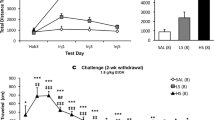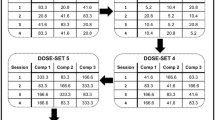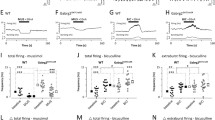Abstract
Rationale
Dopamine D3 receptors (D3Rs) have been implicated in behavioral sensitization to various drugs of abuse, but their role in ethanol (EtOH) sensitization has not been directly examined. We used D3R knockout (D3 KO) mice to examine whether the D3R plays a permissive role in EtOH and amphetamine (AMPH) sensitization. We also investigated whether EtOH sensitization is accompanied by alterations in D3R mRNA expression or binding.
Materials and methods
After comparing EtOH sensitization in C57Bl/6 mice and DBA/2 mice, D3 KO, wild type (WT), and for comparison, D1 and D2 KOs received five biweekly injections of EtOH (2.2 g/kg, i.p.) or saline. Another group of D3 KOs and WT controls received six times AMPH (1.5 mg/kg, i.p.). D3R mRNA and binding were measured in EtOH-sensitized DBA/2 mice with in situ hybridization and [125I]-7-OH-PIPAT autoradiography, respectively.
Results
C57Bl/6 mice expressed EtOH sensitization albeit to a lesser extent than DBA/2 mice. Compared to WT mice, D3 KOs were resistant to EtOH sensitization. The behavioral profile of D3 KOs was more similar to D1 KOs than D2 KOs, which also failed to develop EtOH sensitization. However, D3 KOs developed AMPH sensitization normally. EtOH sensitization was not accompanied by changes in either D3R mRNA or D3R binding in the islands of Calleja, nucleus accumbens, dorsal striatum, or cerebellum.
Conclusions
These results suggest a necessary role for the D3R in EtOH but not AMPH sensitization, possibly through postreceptor intracellular mechanisms. Results also suggest that different neurochemical mechanisms underlie sensitization to different drugs of abuse.





Similar content being viewed by others
References
Anderson SM, Pierce RC (2005) Cocaine-induced alterations in dopamine receptor signaling: implications for reinforcement and reinstatement. Pharmacol Ther 106:389–403
Baik JH, Picetti R, Saiardi A, Thiriet G, Dierich A, Depaulis A, Le Meur M, Borrelli E (1995) Parkinsonian-like locomotor impairment in mice lacking dopamine D2 receptors. Nature 377:424–428
Bancroft GN, Morgan KA, Flietstra RJ, Levant B (1998) Binding of [3H]PD 128907, a putatively selective ligand for the D3 dopamine receptor, in rat brain: a receptor binding and quantitative autoradiographic study. Neuropsychopharmacology 18:305–316
Becker A, Grecksch G, Kraus J, Peters B, Schroeder H, Schulz S, Hollt V (2001) Loss of locomotor sensitisation in response to morphine in D1 receptor deficient mice. Naunyn Schmiedebergs Arch Pharmacol 363:562–568
Bjijou Y, Stinus L, Le Moal M, Cador M (1996) Evidence for selective involvement of dopamine D1 receptors of the ventral tegmental area in the behavioral sensitization induced by intra-ventral tegmental area injections of D-amphetamine. J Pharmacol Exp Ther 277:1177–1187
Brodie MS (2002) Increased ethanol excitation of dopaminergic neurons of the ventral tegmental area after chronic ethanol treatment. Alcohol Clin Exp Res 26:1024–1030
Carboni E, Imperato A, Perezzani L, Di Chiara G (1989) Amphetamine, cocaine, phencyclidine and nomifensine increase extracellular dopamine concentrations preferentially in the nucleus accumbens of freely moving rats. Neuroscience 28:653–661
Chen PC, Lao CL, Chen JC (2007) Dual alteration of limbic dopamine D1 receptor-mediated signalling and the Akt/GSK3 pathway in dopamine D3 receptor mutants during the development of methamphetamine sensitization. J Neurochem 100:225–241
Chiang YC, Chen PC, Chen JC (2003) D(3) dopamine receptors are down-regulated in amphetamine sensitized rats and their putative antagonists modulate the locomotor sensitization to amphetamine. Brain Res 972:159–167
Clifford JJ, Tighe O, Croke DT, Sibley DR, Drago J, Waddington JL (1998) Topographical evaluation of the phenotype of spontaneous behaviour in mice with _targeted gene deletion of the D1A dopamine receptor: paradoxical elevation of grooming syntax. Neuropharmacology 37:1595–1602
Crabbe JC Jr., Johnson NA, Gray DK, Kosobud A, Young ER (1982) Biphasic effects of ethanol on open-field activity: sensitivity and tolerance in C57BL/6N and DBA/2N mice. J Comp Physiol Psychol 96:440–451
Crawford CA, Drago J, Watson JB, Levine MS (1997) Effects of repeated amphetamine treatment on the locomotor activity of the dopamine D1A-deficient mouse. Neuroreport 8:2523–2527
Cunningham CL, Noble D (1992) Conditioned activation induced by ethanol: role in sensitization and conditioned place preference. Pharmacol Biochem Behav 43:307–313
Daly SA, Waddington JL (1993) Behavioural effects of the putative D-3 dopamine receptor agonist 7-OH-DPAT in relation to other “D-2-like” agonists. Neuropharmacology 32:509–510
Di Chiara G, Imperato A (1988) Drugs abused by humans preferentially increase synaptic dopamine concentrations in the mesolimbic system of freely moving rats. Proc Natl Acad Sci USA 85:5274–5278
Drago J, Gerfen CR, Westphal H, Steiner H (1996) D1 dopamine receptor-deficient mouse: cocaine-induced regulation of immediate-early gene and substance P expression in the striatum. Neuroscience 74:813–823
Franklin KBJ, Paxinos G (1997) The mouse brain in stereotaxic coordinates. Academic, San Diego
Guillin O, Diaz J, Carroll P, Griffon N, Schwartz JC, Sokoloff P (2001) BDNF controls dopamine D3 receptor expression and triggers behavioural sensitization. Nature 411:86–89
Guillin O, Griffon N, Bezard E, Leriche L, Diaz J, Gross C, Sokoloff P (2003) Brain-derived neurotrophic factor controls dopamine D3 receptor expression: therapeutic implications in Parkinson’s disease. Eur J Pharmacol 480:89–95
Heidbreder CA, Gardner EL, Xi ZX, Thanos PK, Mugnaini M, Hagan JJ, Ashby CR Jr. (2005) The role of central dopamine D3 receptors in drug addiction: a review of pharmacological evidence. Brain Res Brain Res Rev 49:77–105
Henry DJ, White FJ (1995) The persistence of behavioral sensitization to cocaine parallels enhanced inhibition of nucleus accumbens neurons. J Neurosci 15:6287–6299
Holmes A, Lachowicz JE, Sibley DR (2004) Phenotypic analysis of dopamine receptor knockout mice; recent insights into the functional specificity of dopamine receptor subtypes. Neuropharmacology 47:1117–1134
Hunt WA, Lands WE (1992) A role for behavioral sensitization in uncontrolled ethanol intake. Alcohol 9:327–328
Ikemoto S, Wise RA (2004) Mapping of chemical trigger zones for reward. Neuropharmacology 47(Suppl 1):190–201
Imperato A, Di Chiara G (1986) Preferential stimulation of dopamine release in the nucleus accumbens of freely moving rats by ethanol. J Pharmacol Exp Ther 239:219–228
Itzhak Y, Martin JL (1999) Effects of cocaine, nicotine, dizocipline and alcohol on mice locomotor activity: cocaine-alcohol cross-sensitization involves upregulation of striatal dopamine transporter binding sites. Brain Res 818:204–211
Jung MY, Skryabin BV, Arai M, Abbondanzo S, Fu D, Brosius J, Robakis NK, Polites HG, Pintar JE, Schmauss C (1999) Potentiation of the D2 mutant motor phenotype in mice lacking dopamine D2 and D3 receptors. Neuroscience 91:911–924
Kalivas PW, Stewart J (1991) Dopamine transmission in the initiation and expression of drug- and stress-induced sensitization of motor activity. Brain Res Brain Res Rev 16:223–244
Karasinska JM, George SR, El-Ghundi M, Fletcher PJ, O’Dowd BF (2000) Modification of dopamine D(1) receptor knockout phenotype in mice lacking both dopamine D(1) and D(3) receptors. Eur J Pharmacol 399:171–181
Kelly MA, Rubinstein M, Phillips TJ, Lessov CN, Burkhart-Kasch S, Zhang G, Bunzow JR, Fang Y, Gerhardt GA, Grandy DK, Low MJ (1998) Locomotor activity in D2 dopamine receptor-deficient mice is determined by gene dosage, genetic background, and developmental adaptations. J Neurosci 18:3470–3479
Le Foll B, Diaz J, Sokoloff P (2003) Increased dopamine D3 receptor expression accompanying behavioral sensitization to nicotine in rats. Synapse 47:176–183
Lessov CN, Phillips TJ (1998) Duration of sensitization to the locomotor stimulant effects of ethanol in mice. Psychopharmacology (Berl) 135:374–382
Masur J, Oliveira de Souza ML, Zwicker AP (1986) The excitatory effect of ethanol: absence in rats, no tolerance and increased sensitivity in mice. Pharmacol Biochem Behav 24:1225–1228
McGinty JF, Shi XD, Schwendt M, Saylor A, Toda S (2008) Regulation of psychostimulant-induced signaling and gene expression in the striatum. J Neurochem 104:1440–1449
McNamara FN, Clifford JJ, Tighe O, Kinsella A, Drago J, Croke DT, Waddington JL (2003) Congenic D1A dopamine receptor mutants: ethologically based resolution of behavioural topography indicates genetic background as a determinant of knockout phenotype. Neuropsychopharmacology 28:86–99
McNamara RK, Levant B, Taylor B, Ahlbrand R, Liu Y, Sullivan JR, Stanford K, Richtand NM (2006) C57BL/6J mice exhibit reduced dopamine D3 receptor-mediated locomotor-inhibitory function relative to DBA/2J mice. Neuroscience 143:141–153
Newlin DB, Thomson JB (1991) Chronic tolerance and sensitization to alcohol in sons of alcoholics. Alcohol Clin Exp Res 15:399–405
Newlin DB, Thomson JB (1999) Chronic tolerance and sensitization to alcohol in sons of alcoholics: II. Replication and reanalysis. Exp Clin Psychopharmacol 7:234–243
Orsini C, Buchini F, Piazza PV, Puglisi-Allegra S, Cabib S (2004) Susceptibility to amphetamine-induced place preference is predicted by locomotor response to novelty and amphetamine in the mouse. Psychopharmacology (Berl) 172:264–270
Palmer AA, Low MJ, Grandy DK, Phillips TJ (2003) Effects of a Drd2 deletion mutation on ethanol-induced locomotor stimulation and sensitization suggest a role for epistasis. Behav Genet 33:311–324
Phillips TJ, Dickinson S, Burkhart-Kasch S (1994) Behavioral sensitization to drug stimulant effects in C57BL/6J and DBA/2J inbred mice. Behav Neurosci 108:789–803
Phillips TJ, Huson M, Gwiazdon C, Burkhart-Kasch S, Shen EH (1995) Effects of acute and repeated ethanol exposures on the locomotor activity of BXD recombinant inbred mice. Alcohol Clin Exp Res 19:269–278
Pierce RC, Kalivas PW (1997) A circuitry model of the expression of behavioral sensitization to amphetamine-like psychostimulants. Brain Res Brain Res Rev 25:192–216
Quadros IM, Hipolide DC, Frussa-Filho R, De Lucca EM, Nobrega JN, Souza-Formigoni ML (2002) Resistance to ethanol sensitization is associated with increased NMDA receptor binding in specific brain areas. Eur J Pharmacol 442:55–61
Richtand NM (2006) Behavioral sensitization, alternative splicing, and d3 dopamine receptor-mediated inhibitory function. Neuropsychopharmacology 31:2368–2375
Richtand NM, Logue AD, Welge JA, Perdiue J, Tubbs LJ, Spitzer RH, Sethuraman G, Geracioti TD (2000) The dopamine D3 receptor antagonist nafadotride inhibits development of locomotor sensitization to amphetamine. Brain Res 867:239–242
Richtand NM, Woods SC, Berger SP, Strakowski SM (2001) D3 dopamine receptor, behavioral sensitization, and psychosis. Neurosci Biobehav Rev 25:427–443
Richtand NM, Welge JA, Levant B, Logue AD, Hayes S, Pritchard LM, Geracioti TD, Coolen LM, Berger SP (2003) Altered behavioral response to dopamine D3 receptor agonists 7-OH-DPAT and PD 128907 following repetitive amphetamine administration. Neuropsychopharmacology 28:1422–1432
Robinson TE, Berridge KC (1993) The neural basis of drug craving: an incentive-sensitization theory of addiction. Brain Res Brain Res Rev 18:247–291
Robinson TE, Berridge KC (2000) The psychology and neurobiology of addiction: an incentive-sensitization view. Addiction 95(Suppl 2):S91–S117
Robinson TE, Kolb B (2004) Structural plasticity associated with exposure to drugs of abuse. Neuropharmacology 47(Suppl 1):33–46
Schmidt LG, Dufeu P, Kuhn S, Smolka M, Rommelspacher H (2000) Transition to alcohol dependence: clinical and neurobiological considerations. Compr Psychiatry 41:90–94
Sibley DR, Creese I (1983) Regulation of ligand binding to pituitary D-2 dopaminergic receptors. Effects of divalent cations and functional group modification. J Biol Chem 258:4957–4965
Stanwood GD, Artymyshyn RP, Kung MP, Kung HF, Lucki I, McGonigle P (2000) Quantitative autoradiographic mapping of rat brain dopamine D3 binding with [125I] 7-OH-PIPAT: evidence for the presence of D3 receptors on dopaminergic and nondopaminergic cell bodies and terminals. J Pharmacol Exp Ther 295:1223–1231
Svensson K, Carlsson A, Huff RM, Kling-Petersen T, Waters N (1994) Behavioral and neurochemical data suggest functional differences between dopamine D2 and D3 receptors. Eur J Pharmacol 263:235–243
Tassin JP (2008) Uncoupling between noradrenergic and serotonergic neurons as a molecular basis of stable changes in behavior induced by repeated drugs of abuse. Biochem Pharmacol 75:85–97
Tritto T, Dudek BC (1994) Differential activating effects of ethanol in C57BL/6Abg and DBA/2Abg mice. Alcohol 11:133–139
van Kampen JM, Stoessl AJ (2003) Effects of oligonucleotide antisense to dopamine D3 receptor mRNA in a rodent model of behavioural sensitization to levodopa. Neuroscience 116:307–314
Ventura R, Alcaro A, Cabib S, Conversi D, Mandolesi L, Puglisi-Allegra S (2004) Dopamine in the medial prefrontal cortex controls genotype-dependent effects of amphetamine on mesoaccumbens dopamine release and locomotion. Neuropsychopharmacology 29:72–80
Vezina P (1996) D1 dopamine receptor activation is necessary for the induction of sensitization by amphetamine in the ventral tegmental area. J Neurosci 16:2411–2420
Vezina P (2004) Sensitization of midbrain dopamine neuron reactivity and the self-administration of psychomotor stimulant drugs. Neurosci Biobehav Rev 27:827–839
Wallace DR, Mactutus CF, Booze RM (1996) Repeated intravenous cocaine administration: locomotor activity and dopamine D2/D3 receptors. Synapse 23:152–163
Wise RA (2002) Brain reward circuitry: insights from unsensed incentives. Neuron 36:229–240
Wise RA, Leeb K (1993) Psychomotor-stimulant sensitization: a unitary phenomenon? Behav Pharmacol 4:339–349
Wong JY, Clifford JJ, Massalas JS, Finkelstein DI, Horne MK, Waddington JL, Drago J (2003a) Neurochemical changes in dopamine D1, D3 and D1/D3 receptor knockout mice. Eur J Pharmacol 472:39–47
Wong JY, Clifford JJ, Massalas JS, Kinsella A, Waddington JL, Drago J (2003b) Essential conservation of D1 mutant phenotype at the level of individual topographies of behaviour in mice lacking both D1 and D3 dopamine receptors. Psychopharmacology (Berl) 167:167–173
Xu M, Hu XT, Cooper DC, White FJ, Tonegawa S (1996) A genetic approach to study mechanisms of cocaine action. Ann N Y Acad Sci 801:51–63
Xu M, Koeltzow TE, Santiago GT, Moratalla R, Cooper DC, Hu XT, White NM, Graybiel AM, White FJ, Tonegawa S (1997) Dopamine D3 receptor mutant mice exhibit increased behavioral sensitivity to concurrent stimulation of D1 and D2 receptors. Neuron 19:837–848
Xu M, Guo Y, Vorhees CV, Zhang J (2000) Behavioral responses to cocaine and amphetamine administration in mice lacking the dopamine D1 receptor. Brain Res 852:198–207
Zapata A, Gonzales RA, Shippenberg TS (2006) Repeated ethanol intoxication induces behavioral sensitization in the absence of a sensitized accumbens dopamine response in C57BL/6J and DBA/2J mice. Neuropsychopharmacology 31:396–405
Zeng BY, Pearce RK, MacKenzie GM, Jenner P (2001) Chronic high dose L-dopa treatment does not alter the levels of dopamine D-1, D-2 or D-3 receptor in the striatum of normal monkeys: an autoradiographic study. J Neural Transm 108:925–941
Acknowledgements
This study was supported by NSERC grant no. RGPIN 170079-04. The authors thank Ashlie Soko, Katrina Deverell, and Tiffany Antopolski for breeding, maintaining, and genotyping the transgenic mice used in this study as well as Roger Raymond for the technical support in the laboratory.
Author information
Authors and Affiliations
Corresponding author
Rights and permissions
About this article
Cite this article
Harrison, S.J., Nobrega, J.N. Differential susceptibility to ethanol and amphetamine sensitization in dopamine D3 receptor-deficient mice. Psychopharmacology 204, 49–59 (2009). https://doi.org/10.1007/s00213-008-1435-x
Received:
Accepted:
Published:
Issue Date:
DOI: https://doi.org/10.1007/s00213-008-1435-x




